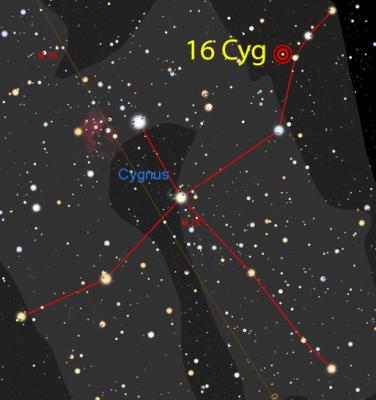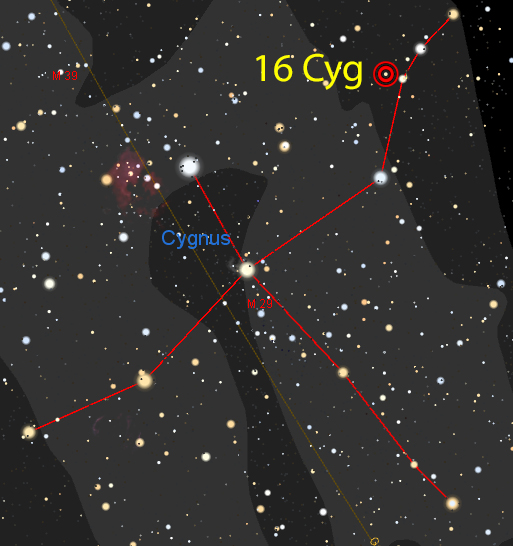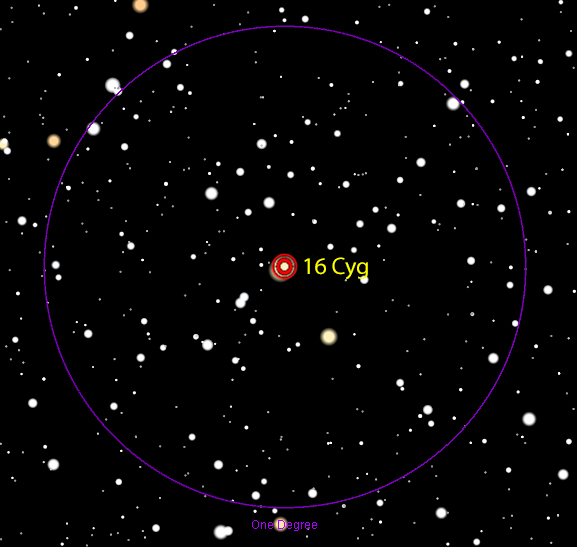 For those of us who are interested in stellar evolution, the December 2017 issue of Astronomy magazine has several articles of interest. The cover story is “Why has the Sun Gone Quiet”, and this article discusses how astronomers are studying the Sun and Sun-like stars to better understand and predict the future of our Sun.
For those of us who are interested in stellar evolution, the December 2017 issue of Astronomy magazine has several articles of interest. The cover story is “Why has the Sun Gone Quiet”, and this article discusses how astronomers are studying the Sun and Sun-like stars to better understand and predict the future of our Sun.
 By Bill Pellerin
By Bill Pellerin
Object: 16 Cyg, Struve 46
Class: Sun-like stars, double star
Constellation: Cygnus
Magnitude: 5.4 (A), 8.75 (B)
R.A.: 19h 41m 48s
Dec: +50° 34′ 49″
Size/Spectral: G2, G5
Distance: 69 ly
Optics needed: A small telescope
For those of us who are interested in stellar evolution, the December 2017 issue of Astronomy magazine has several articles of interest. The cover story is “Why has the Sun Gone Quiet”, and this article discusses how astronomers are studying the Sun and Sun-like stars to better understand and predict the future of our Sun.
One of the stars being studied is this month’s object, 16 Cyg, a G class double star, each star is like our Sun.
This star is at opposition in early September, but it’s visible from June through November. As the finder chart shows, you should be able to find the star easily near the western wing of Cygnus the swan. Sunset is about 4:30 p.m., and astronomical twilight begins about 6:00 p.m, so the skies should be quite dark by 6:45 p.m..
 This star is a two-fer… you get two observations for your efforts because it’s a Sun-like star and because it’s a double star. Each of the stars in the pair is a G class star. As a double star, the separation is about 40” and the position angle is about 195°, meaning that the secondary star is just west of due south of the primary star. The primary star is a bright 5.4 magnitude star and the secondary star is a dimmer 8.75 magnitude star, but the pair should be easily visible under dark skies with a small telescope.
This star is a two-fer… you get two observations for your efforts because it’s a Sun-like star and because it’s a double star. Each of the stars in the pair is a G class star. As a double star, the separation is about 40” and the position angle is about 195°, meaning that the secondary star is just west of due south of the primary star. The primary star is a bright 5.4 magnitude star and the secondary star is a dimmer 8.75 magnitude star, but the pair should be easily visible under dark skies with a small telescope.
Why is this interesting?
The two components of the double star are called A and B (pretty clever, huh?) so if you talk about these stars you should say, “16 Cyg A” (the brighter star), or “16 Cyg B” to sound like a real astronomer. These stars are interesting to study because they are not only G stars, similar to our Sun, they are 2 billion years older than our Sun. Studying these stars may give us some hints about the fate of our star.
The article in Astronomy magazine is generally about solar sunspot cycles and whether the stars settle down in old age and produce fewer sunspots. This pair, being older than our Sun, is being studied to try to understand what happens as stars age.
The orbit of these two stars is not well known, so the period of the orbit is not known as well. There’s another surprise with this system; 16 Cyg B has its own exoplanet, discovered in 1996. It is not thought that the system has an Earth-like planet, however.
By the way, star spots are detected by astronomers by measuring the magnetic field of the star or by spectral analysis (measuring the rise and fall of some spectral lines).
Clear skies.
Captions
Finder chart. Star chart generated by TheSkyX © Software Bisque, Inc. All rights reserved.



